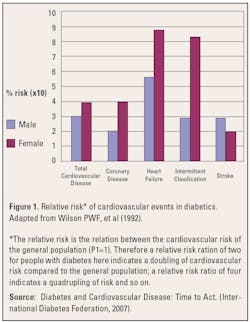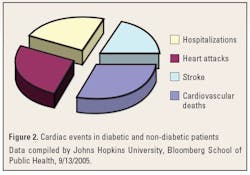Diabetes mellitus
is a disease that can have significant morbidity if not diagnosed and
treated properly. Diabetes as a disease entity is growing exponentially in
the United States as well as in many European countries.1 The
number diabetics in the United States alone has surpassed the 16 million
mark. In addition, about 2.3 million people may have diabetes and not even
know it. Diabetes mellitus is a condition in which the level of glucose in
the blood becomes too high because the body is unable to process it
properly. This results from either an inability to produce insulin or
because the body has become resistant to the insulin produced by the
pancreas. Insulin is a hormone produced in the pancreas, which controls
almost all assimilation of glucose into the body’s tissues and organs, while
maintaining a delicate concentration of glucose for the body to use.2
All organs and body tissue require glucose for
metabolism and proper function; however, the brain and nervous system are
particularly dependent on and cannot function without glucose. When serum
glucose levels are not maintained within a small concentration, disease
processes often begin.2 When insulin is reduced, glucose levels
remain high in the bloodstream and cells “starve,” as glucose is the main
energy source for body cells. Without the assimilation of glucose, the body
cannot manufacture the high-energy compound adenosine triphosphate (ATP),
the body’s power molecule. When glucose levels in the blood are high but low
in tissue and organs, the body begins to metabolize fatty acids for energy.
This process is much less efficient than the proper use of glucose and leads
to a buildup of ketones in the blood and tissue. The resulting condition is
ketoacidosis and greatly upsets the body’s acid-base balance.1,2
Ketoacidosis can cause both short- and long-term complications.
Coronary risk associated with diabetes
Coronary risk is defined as the amount of risk a
patient holds based on several factors.2 Hereditary and genetic factors
cannot be changed or minimized but can be addressed by lifestyle changes and
attention to health status. Risk factors influencing coronary or cardiac
risk include diet, cigarette smoking, age, weight, and lifestyle. Coupled
with this is family history of heart disease and heart attack, which further
amplifies the risk of developing coronary disease.
Studies have shown that patients with diabetes are at
a higher risk for cardiac involvement and cardiac-related risks.3
Research also suggests that patients with elevated hemoglobin A1c (a
component of hemoglobin that is affected in diabetic patients) were more
prone to cardiac risk and heart attack.3 Further evaluation of
patients with diabetes revealed that the risk of stroke was increased
twofold in patients with an elevated hemoglobin A1c level when tested over a
one-year period.3 Figure 1 illustrates the risk of cardiac
involvement in patients with diabetes. In the diabetic patient, due to the
mean increase of glucose in the bloodstream, LDL and HDL cholesterol ratios
are often inverted.4 Cholesterol levels over 200 mg/dL are
dangerous to the general population but more so in diabetic patients.
Increased serum cholesterol levels can lead to rapid acceleration of the
possibility for cardiovascular events.4
Importance of blood glucose and cardiac risk testing
Most routine test panels include a glucose test to
monitor the mean serum glucose levels of almost every patient. In patients
with known diabetes or cardiovascular disease, glucose testing becomes much
more important. Clinical studies have shown that reducing blood-glucose
levels can reduce the associated morbidity risk of cardiovascular disease.
In terms of diabetes testing, hemoglobin A1c is a key indicator of diabetic
control as well as risk of cardiac involvement in acute as well as chronic
events. Hemoglobin A1c, an indicator of morbidity risk in both diabetic and
non-diabetic patients, is a crucial indicator in terms of long-term glucose
management and its relationship to cardiovascular episodes.
During 1990 to 1992, researchers examined data from
the Arthrosclerosis Risk in Communities Study (ARIC),5 a
community-based cohort of almost 16,000 people from four states — North
Carolina, Mississippi, Maryland, and Minnesota. A1c levels were taken from
study participants during clinical exams, and patients were tracked for 10
to 12 years for their propensity to acquire coronary heart disease,
hospitalization, and death.5 The study showed a graded
association between A1c levels and increased cardiovascular risk. The final
results showed that each one percentage point increase in the participant’s
A1c level was associated with a 14% increase in heart-disease risk.5
Study researchers determined that an acceptable A1c level ranges between 5%
and 7%.5
Hemoglobin A1c has become, within the past 10 to 12
years, the number one indicator of diabetic control, and is now being
evaluated as a blanket screen for all patients to determine not only
diabetic risk but also cardiovascular-disease risk as well. Diabetes is a
strong risk factor for cardiovascular-event risk. But even in patients
without diabetes, an increase in cardiac-event risk was proportional to an
increase in blood glucose. Researchers tracked 5,484 patients, both with and
without diabetes, and evaluated the effects of elevated glucose levels on
cardiovascular deaths, heart attacks, strokes, and hospitalization for
cardiovascular events. Figure 2 demonstrates the results of this study
conducted by Johns Hopkins University, Bloomberg Health Center.5
When researchers examined fasting blood-glucose
levels alone as a risk factor by adjusting for other known risk factors,
they found that, for all patients, an increase of 1 mmol/L above a patient’s
entry glucose level increased the risk of hospitalization by 5%. Similarly,
a 1 mmol/L rise increased the risk of congestive heart failure,
hospitalization, or cardiovascular death by 9% for all patients, by 3% for
patients without diabetes, and 5% for patients with diabetes. Even in the
normal range, results indicate that elevated blood-glucose levels are
associated with the risk of heart failure or death from cardiovascular
events.2
As demonstrated, patients with diabetes are at
increased risk for cardiovascular events and cardiovascular death. Patients
without diabetic involvement, however, still share a considerable risk for
increased cardiac events.5 By testing patients, especially
diabetics, regularly for blood-glucose levels, hemoglobin A1c, and cardiac
risk, physicians have a better overall picture of the patient’s health and
prognosis. By using other potential risk factors, such as current health
status, family history, and lifestyle factors, patient health can be better
managed; and diabetics can enjoy a better quality of life while managing
their disease.
It is difficult to overemphasize the need for
diabetic- and cardiac-risk testing in all adult patients. By testing
regularly for these conditions, physicians are able to better manage
disease, recognize potential negative implications, prevent exacerbation of
current disease, and treat events more effectively. The increase in the
availability of newer and better diabetic and cholesterol-lowering drugs has
added to the arsenal of weapons available to fight these diseases and reduce
the morbidity of diabetic complications.
Richard Peluso, MT(AACC), BSHA, attended Felician
College in Lodi, NJ, and received his MBA in Healthcare Management from
University of Phoenix working as a product manager for Alfa Wassermann
Diagnostic Technologies.
References
- Sacks D, Bruns D, Goldstein D, Maclaren N, McDonald J, Parrott M.
Guidelines and Recommendations for laboratory Analysis in the Diagnosis
and Management of Diabetes Mellitus. Clin Chem.
2002;48(3):436-472. - Dr. Laurence M. Demers, Distinguished Professor, AACC Past
President, Penn State University, Personal interview, (January,
2008) - Lab Tests Online “Diabetes Mellitus.” 2008 Available at
http://www.labtestsonline.org/conditions/Diabetesmellitus.html .
Accessed on August 1, 2008.
Johns Hopkins University, School of Public Health. 2005. High
Blood Sugar Levels: A Risk Factor for Heart Disease. Available at
http://www.jhsph.edu/se/util/display_mod.html . Accessed on August 10, 2008. American Heart Association Health Journal.
Even “High Normal” Glucose Levels May Increase the Risk of
Hospitalization for Heart Failure in People at High Cardiovascular
Risk. Available at
http://www.americanheart.org/presenter.jhtml?identifier=3045833
. Accessed on August 12, 2008.



